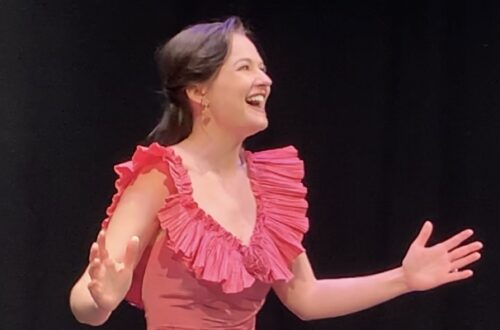-
Using Linguistics to Scaffold Children for School and Promote Positive and Diverse Representation
Georgetown University, 2020. Linguistics. This assignment comes from my General Linguistics summer course and was a collaboration with Sara Grzywacz. We created a proposal and preliminary mock-up for a preschool storybook that includes strategically designed questions and activities built into the text of the story to help caregivers of all kinds prepare their children for school, in an entertaining and appealing way. Below, I’ve shared our presentation for our design. Though we were only able to touch on this in our presentation, our research is informed by work from Shirley Brice Heath (1982), Frederick Erickson (2004), William Labov (2006), and Rosina Lippi-Green (2012). The story we’ve used is Disney’s Cinderella…
-
Multimodal Microanalysis: Scattergories! Video Clip
Georgetown University, 2020. Linguistics: Multimodal Interaction Analysis. Professor: Frederick Erickson. It was a great privilege to work in a small group setting with the seminal scholar Frederick Erickson! Our course centered on learning to transcribe and microanalyze video – a complicated task, due to the immense amount of visual and auditory information captured through this medium. If you’ve ever wondered how researchers might represent data from video, keep reading! Here, I’m presenting my final project, which not only shows you my final product, but also walks through my process for developing this multimodal transcription. The video is from a game of “Scattergories,” in which my mom, fiancé, two cats, and…
-
“It’s pretty hard”: Stance and Dialogicality
Georgetown University, 2020. Linguistics. [Sharing below a short paper from Discourse Analysis: Conversation, applying Du Bois (2007) to my data. My conversation data recording and transcripts are available here.] According to Du Bois’ (2007) definition, “it’s pretty hard” is an expression of stance, and arriving at its meaning and interactional significance can only be achieved through identification of the participants involved, the object discussed, and the utterances that led to this remark. Du Bois writes, “[i]n taking a stance, the stancetaker (1) evaluates an object, (2) positions a subject (usually the self), and (3) aligns with other subjects” (163). This predicates that stance acts include more than one subject…
-
Conversation Shaping: The Impact of Questions on Conversational Direction
Georgetown University, 2020. Linguistics. [Sharing below a short paper from Discourse Analysis: Conversation, applying Sacks, Schegloff, and Jefferson (1974) to my data. My conversation data recording and transcripts are available here.] In a pioneering article describing the way conversational turn-taking is structured, Sacks, Schegloff, and Jefferson (1974; referred to as SSJ throughout) detail fourteen “facts” (700) found to occur in natural conversations, which govern the composition and procurement of speech turns. The focus of this paper concerns certain “turn allocation techniques” (716) employed by a current speaker to select the next speaker (SSJ’s twelfth fact). In particular, I will examine the use of question-answer adjacency pairs, the first part of…
-
Biscotti/Highlander Transcription
Georgetown University, 2020. Linguistics. Discourse Analysis: Conversation. [The recording and transcriptions below correspond with several short papers shared on my site. I’ve also provided commentary related to the transcription process itself, as I worked with three ways types of formatting: play script, column, and quasi-musical score.] Conversation Excerpt: Play Script Transcription This was my debut transcribing an excerpt of this length, genre (natural speech), and with myself as a participant. Though I could relate to much of what Bucholtz (2007) and Ochs (1979) described, it was primarily from a conceptual standpoint, rather than that of an active practitioner. I found it both fun and challenging; at times, it was…
-
Linguistic Landscapes of Inclusion
Georgetown University, 2020. Linguistics. [Sharing below a recent assignment from my General Linguistics summer course, where we were asked to observe and analyze certain elements of our linguistic landscape (because of COVID-19, much of this moved online).] Linguistic landscapes concern the language we see and hear around us every day – from official sources to advertisements to graffiti and personal conversations. From my professor: “Linguistics landscape study involves the systematic investigation of public language and how it may illuminate such sociolinguistic concerns as language and power, language and immigration, language and globalization, language maintenance and shift, language and politics, language and economic factors, and language and cultural, interpersonal, and personal…
-
Schegloff (1982) and Listener Backchannels
Georgetown University, 2020. Hi, everyone! Today’s #WeeklyWednesday is a presentation I gave recently for a Linguistics course in Discourse Analysis of Conversation at Georgetown University. I hope you enjoy seeing some of what I’m working on there! Part of this course has included recording and transcribing an excerpt from a conversation that we were a part of (mine is with my fiancé). This assignment is applying a particular course reading to my conversational data. Below are some key points from the reading and a video of my presentation. I hope you enjoy it! READING APPLIED: Schegloff (1982) “Discourse as an interactional achievement: Some uses of ‘uh huh’ and other things…
-
Sensory Experience: Olfaction
Georgetown University, 2020. Linguistics: Multimodal Interaction Analysis. [Assignment prompt: for a day on campus, keep track of your reactions to ambient smells, in differing spaces outside and inside campus buildings. Draw a map that identifies especially pleasant/satisfying smells and especially unpleasant/disturbing smells. Discuss the sites of these olfactory experiences and your reactions.] Monday morning, January 13, 2020: I disembark the Metrobus on the street level below the main lawns of Georgetown’s campus and begin slowly walking downhill toward the Walsh Building. The streets are nearly empty of pedestrians and automobiles in operation. I detect mild scents of earth and dirt, but mostly notice that the air feels thick in my nostrils. It surprises me that…







